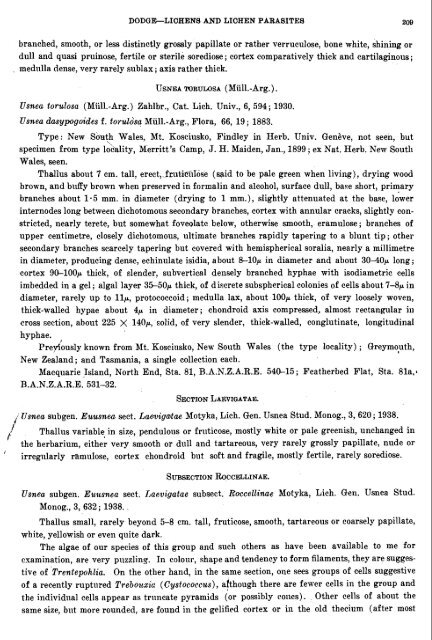Create successful ePaper yourself
Turn your PDF publications into a flip-book with our unique Google optimized e-Paper software.
I'<br />
DODGE--<strong><strong>LICHEN</strong>S</strong> lLND <strong>LICHEN</strong> <strong>PARASITES</strong> 209<br />
branched, smooth, or less distinctly grossly papillate or rather verruculose, bone white, shining or<br />
dull and quasi pruinose, fertile or sterile sorediose; cortex comparatively thick and cartilaginous;<br />
. medulla dense, very rarely sublax ; axis rather thick.<br />
Usnea torulosa (Miil1.-Arg.) Zahlbr., Cat. Lich. Univ., 6, 594 ; 1930.<br />
Usnea da.sypvgoides f. toddsa Miill.-Arg., Flora, 66, 19; 1883.<br />
Type: New South Wales, Mt. Kosciuslro, Findley in Herb. Univ. GenBve, not seen, but<br />
\<br />
specimen from type loc'ality, Merritt's Camp, J. H. Maiden, Jan., 1899 ; ex Nat. Herb. New South<br />
Wales, seen.<br />
Thallus about 7 cm. tall, erect,f ruMlIose (sirid to be pale green when living), drying wood<br />
brown, and buffy brown when preserved in formalin and alcohol, surface dull, base short, primary<br />
branches about 1-5 mm. in diameter (drying to 1 mm.), slightly attenuated at the base, lower<br />
internodes long between dichotomous secondary branches, cortex with annular cracks, slightly con-<br />
stricted, nearly terete, but somewhat foveolate below, otherwise smooth, eramulose; branches of<br />
upper centimetre, closely dichotomous, ultimate branches rapidly tapering to a blunt tip ; other<br />
secondary branches scarcely tapering but covered with hemispherical soralia, nearly a millimetre<br />
in diameter, producing dense, echinulate isidia, a bout 8-lop in diameter and about 3040p long ;<br />
cortex 90-100p thick, of slender, subvertical deilsely branched hyphae with isodiametric cells<br />
imbedded in a gel; algal layer 35-50p thick, of discrete subspherical colonies of cells about 7-8p in<br />
diameter, rarely up to llp, protococcoid; medulla lax, about 100p thick, of very loosely woven,<br />
thick-walled hypae about 4p in diameter; chondroid axis compressed, almost rectangular in<br />
cross section, about 225 X 140p, solid, of very slender, thick-walled, conglutinate, longitudinal<br />
hyphae.<br />
previously known from &It. Kosciusko, Nea South Wales (the type locality) ; Greymoyth,<br />
New Zealand; and Tasmania, a single collection each.<br />
Macquarie Island, North End, Sta. 81, R.A.N.Z.A.R.E. 540-15; Featherbed Flat, Sta. 81a,b<br />
B.A.N.Z.A.R.E. 531-32.<br />
SECTION LAEVIQATAE.<br />
,I TJsnea subgen. Euusnea sect. Laevigatae Motyka, Lich. Gen. Usnea Stud. Monog., 3,620; 1938.<br />
Thallus variable in size, pendulous or fr~~ticose, mostly white or pale greenish, unchanged in<br />
the herbarium, either very smooth or dull and tartareous, very rarely grossly papillate, nude or<br />
irregularly ramulose, cortex chondroid but soft and fragile, mostly fertile, rarely sorediose.<br />
SUBSECTION ROCCELLINAE.<br />
Usnea subgen. Euusnea sect. I,ap,vigatae subsect. Roccellinae Motylra, Lich. Gen. Usnea Stud.<br />
Monog., 3, 632 ; 1938.<br />
Thallus small, rarely beyond 5-8 cm. tall, fruticose, smooth, tartareous or coarsely papillate,<br />
white, yellowish or even quite dark.<br />
The algae of our species of this group and such others as have been available to me for<br />
examination, are very puzzling. In colonr, shape and tendency to form filaments, they are sugges-<br />
tive of Trentepohlia. On the other hand, in the same section, one sees groups of cells suggestive<br />
of a recently ruptured Trebozlzic (Gystococczcs), afthough there are fewer cells in the group and<br />
the individual cells appear as truncate pyramids (or possibly cones). Other cells of about the<br />
same size, bnt more rounded, are found in the gelified cortex or in the old thecium (after most

















